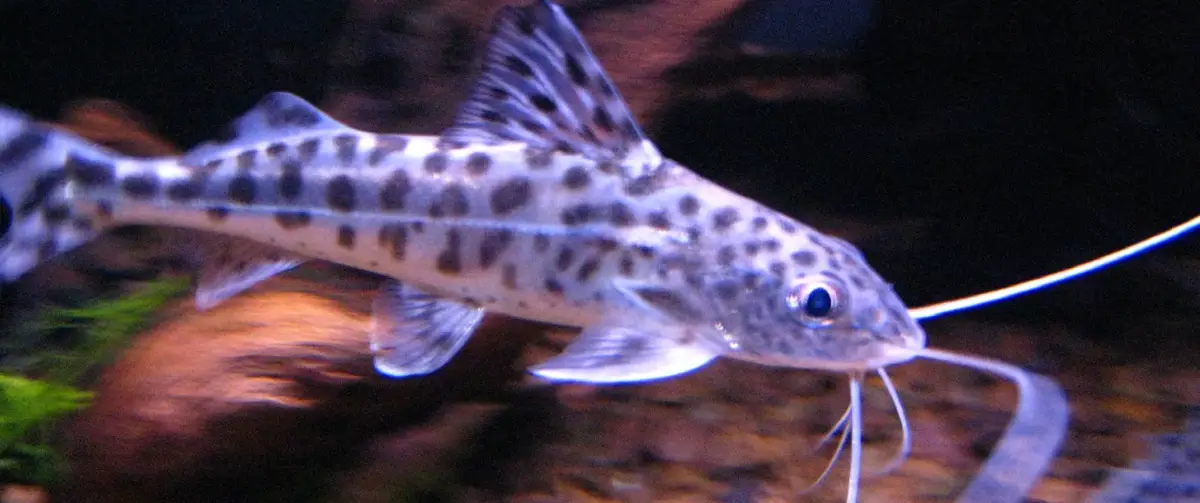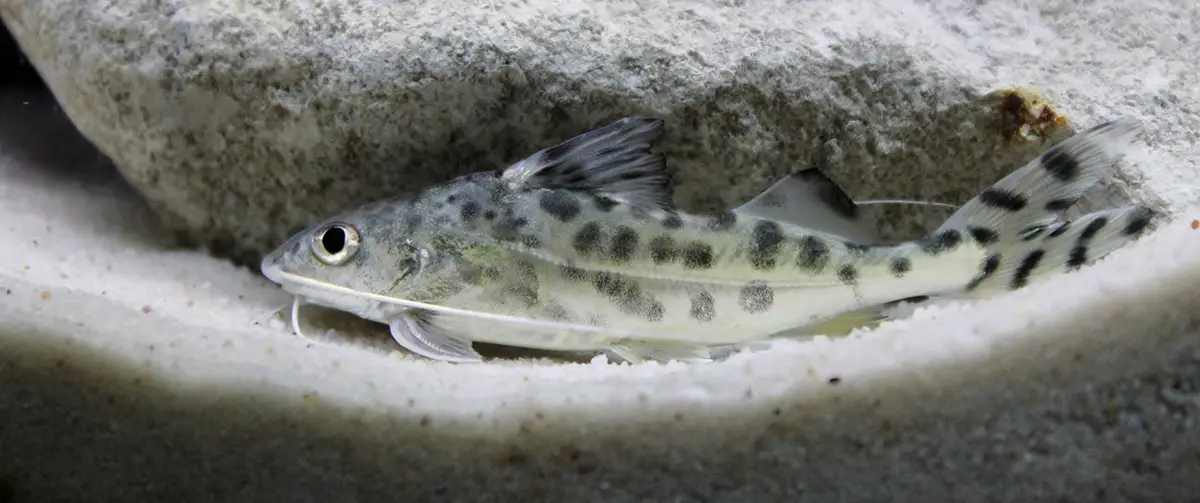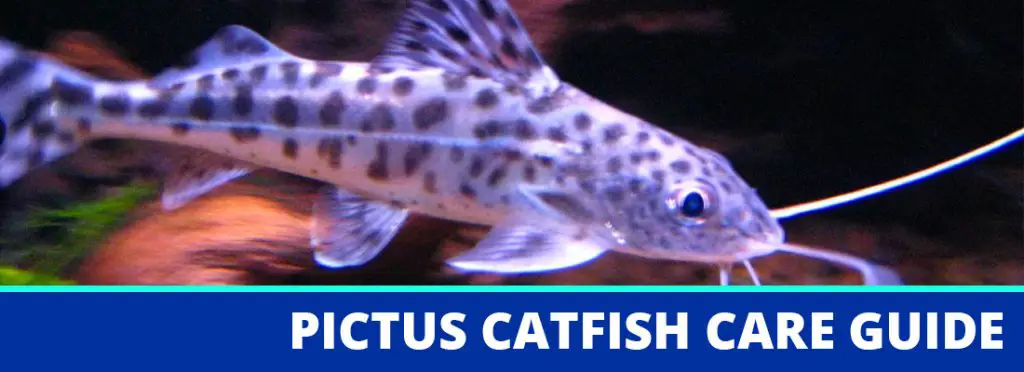One of the most popular bottom dweller fish in the fishkeeping hobby is the Pictus Catfish, a fun, unique little fish with popping colors and energetic personalities. It’s not the easiest fish to care for, despite being so popular, though, because it’s a sensitive fish with some very specific needs.
Chances are, though, if you’re reading this, it’s because you’re just not sure of much about this fish, so, our goal is to detail as much as we can in this Pictus catfish care sheet. So, if you’re wondering, “what do pictus catfish eat?” Or “how big do Pictus catfish get?” you’ve come to the right place.

Quick Intro to Pictus Catfish
| Family | Pimelodidae |
| Scientific Name | Pimelodus Pictus |
| Other Names | Angelicus Catfish, Polka Dot Fish, Polka Fish, Pictus Cat, pimelodella catfish, pimelodus pictus |
| Care Level | Moderate to Advanced |
Natural Habitat, Identification, and Where to Buy
The Pimelodus Pictus, or Pictus Catfish, is native to South American streams and rivers across the Amazon region and the Orinoco Rivers in Colombia and Peru. This little fish is often confused with the upside-down catfish species (or redtail catfish), Synodontis, but those guys come from Africa – very different fish, even if they look a little similar.
This type of fish needs fresh water to live. It is also a bottom dweller that sleeps during the day and comes out as darkness falls. It has a diet that involves fruits, insects, snails, prawns, and even smaller fish.
The easiest way to recognize them is to look for silver-colored skin that is covered with black spots.
The fish is long and slender and in captivity is known to grow upwards of five inches. Like all catfish, it has barbels, also called “whiskers”. While swimming, the fish use its barbels to help navigate in muddy waters.
Once you’re ready to find some Pictus Catfish to purchase, you can visit your local pet store or shop online at many locations. Top recommendations from sites we trust for this include:
Optimal Water Conditions for Pictus Catfish
| Pictus Catfish Temperature | 72 to 77-degrees Fahrenheit |
| Water Flow Rate | Slow flow rate |
| pH | 5.5-7.0 |
| Hardness | 5 to 18 dH |
Tank Setup
| Minimum Pictus Catfish Tank Size | 55 Gallons + |
| Optimal Tank Size | 55 Gallons + |
| Optimal Tank Shape | Rectangular standard or long |
| Recommended Filter Type | HOB or others with high flow rate |
| Extra Air Flow and How to Provide | Air stones and powerful water filters are the best way to give these guys great air flow they need without overwhelming them. Depending on the size tank they live in, there should be enough filtration to help keep things clean with air stones added for a little bit of current and oxygenation without going overboard. |
You should emulate their natural environment as closely as possible. That means you should provide them with mild, slow-moving air flow. After all, they naturally live in rivers that flow steadily but smoothly.
The environment in these rivers is also warm with sandy riverbeds. We’ll talk more about ideal conditions below with this, but this definitely means providing them with a sandy substrate and housing them with other fish that need this same kind of environment.
The filtration system is a key factor in keeping your silver catfish with black spots healthy and happy. These fish are bottom dwellers, which means they clean some things up, but they’re also huge waste producers, which means, well, a good quality HOB filter will do double-duty with solid filtration and creating water flow.
Creating the Landscape
Since Pictus catfish naturally live in wild locations with sandy bottoms, river rocks, live plants, and other fish, it’s important to recreate this kind of landscape as closely as possible. You can do this through several simple things, starting with the substrate.
Choose a natural, but clean, sand for the bottom of the tank. Layer in some treated river rocks, large pebbles, or similar décor items. Provide the Pictus Catfish with live plants to hide in and play around. They’re very active fish and need to have this kind of environment in an aquarium to help keep them active and healthy without getting bored.
Pictus also do well with treated driftwood, rocks, caves, and even places like overturned flowerpots, PVC pipes, and similar spots for hidey holes. They do, however, also need large, open spaces for swimming and exercising in.
They should have tanks that provide them with low lights at night, as they are primarily nocturnal, and nothing too bright during the day. So, don’t house them with fish and plants that need loads of light all day.
| Best Plants | Java Moss, Hornwort, Moss balls, other low-light plants |
| Best Lighting | Dimly lit with shadowy spots throughout the tank during daylight hours |
| Best Decorations | Sandy substrate, river rocks, caves, treated driftwood, live plants |
| Decorations to Avoid | Anything with sharp edges that will snag their fins |
Physiological Considerations
| Pictus Catfish Size | Up to 5-inches |
| Pictus Catfish Lifespan | 8+ Years |
| Temperament | Peaceful |
| Preferred Tank Region | Bottom to middle |
| Scale Thickness | Pictus Catfish do not have scales. This means they are more susceptible to diseases common in aquarium fish. Water quality is crucial to prevent these illnesses from taking over. |
| Gill Considerations | Pictus Catfish are very sensitive to ammonia and nitrates. Water quality is absolutely crucial for their health. If you notice their gills changing colors at all, immediately test water parameters and make changes as guided by care information. |
| Swimbladder Considerations | Pictus Catfish are sensitive to swim bladder conditions. Overfeeding and poor filtration are huge for this area of their health. Make sure you use all types of filtration (biological, chemical, and mechanical) to keep these issues in check. |
| Fin Shape Considerations | Avoid any objects in the tank with sharp edges that may snag the fins and fail tins of your Pictus Catfish. |
This spotted Pictus Catfish comes in black and white color combinations, varying slightly by fish, of course. Many are a bit more silver in color, rather than white, and they have transparent fins with white barbels. They have long, slender bodies, and grow up to 5-inches in length, in captivity.
Like many other catfish species, they also have their “whiskers” that are what are known as barbels. These help them navigate murky and muddy waters, allowing them to function well in their native environments of rivers and streams.
Society
Pictus Catfish are naturally peaceful fish that get along with many other species of small, non-aggressive fish.
They do, however, have sharp spines that can sometimes cause harm to other fish – not because these guys are trying to hurt others, but because they’re naturally very sharp and just get in the way of free movement of other fish. This is part of why large swimming areas are important for them if they’re housed with other fish.
Pictus catfish behavior makes them ideal for housing with many other Pictus catfish, and they should, in fact, be kept in groups of five. This helps with any possibility of aggression towards one another and other fishes, because of reducing territorial concerns with mates, et cetera.
And though they are non-aggressive and non-territorial in general, Pictus catfish compatibility is still specific, for several reasons.
Pictus catfish will eat smaller fish if they’re hungry. So, they shouldn’t be housed with fish much smaller than they and should always be fed according to their usual schedule that’s been tested and tried.
Pictus catfish are also sometimes sold as general community fish. They definitely have some tank mates they can get along with, but popular community fish like neons and guppies aren’t usually them.

Instead, the best Pictus Catfish tank mates include:
- Giant danios
- Opaline gourami
- Striped Raphael Catfish
- Other catfish
- Clown loaches
- Rainbow sharks
- Tiger barbs
- Other large fast-moving fish
As far as other popular fish, you should not house Pictus catfish with African cichlids, guppies, tetras, barbs, bettas, and, well, any other fish that’s aggressive or smaller than a Pictus catfish full grown.
Gender, Breeding, and Reproductive Considerations
This silver and black fish is a very difficult critter to determine the gender of. It’s often thought that females are larger than males, but there’s not any confirmation of this. Some claim they’ve seen a difference, but long-time aquarists have struggled to identify which is male and which is female.
So, that means that Pictus catfish can be one of the most difficult fish to breed in captivity. In fact, if you research this online, you’ll discover almost no one has successfully done so at home. Not knowing which fish should be paired together for breeding is only one aspect of this difficulty.
Another, and potentially more important issue with this breeding dilemma, is that home aquariums aren’t typically large enough for the fish to actually reach full sexual maturity. They need incredible amounts of space to fully develop. So, unless you can house several shoals of Pictus – groups of 5 or more – each in their own 200-gallon+ fish tank, you’re unlikely to be successful.
Another problem is that very little is known about the breeding characteristics and behaviors of this fish. In the wild, they lay eggs, which means that females lay them and then males fertilize them. But that knowledge doesn’t help much with breeding them at home.
Nutritional Needs
One of the most important aspects of keeping your Pictus healthy and happy is knowing the right Pictus Catfish food.
In the wild, Pictus are scavengers and eat just about anything they find. This is why they tend to hang out in the bottom and middle regions of your aquarium. And since they are omnivorous by nature, they eat plants along with insects, worms, and other animal-based foods.
They particularly seem to enjoy dragonfly larvae, snails, small fish, and algae – though, of course, some of these are not readily available for us to feed to them.
| Best Sustenance Food Type | Fresh brine shrimp, fresh beef heart, frozen and freeze-dried bloodworms and blackworms |
| Additional Food for Optimal Health | Fresh vegetables, diced into tiny bits, algae wafers |
| Special Foods and Considerations for Best Color and Growth | A quality balance of fresh and frozen protein, algae wafers, and high-quality (zero or low-grain) pellets |
| When and How Often to Feed Fish Based on Life Cycle | 1 to 2 times daily is ideal, though keep an eye on their behavior to see if they need to be fed more often. If they grow aggressive at all towards other fish, increase feeding to 3 times daily and see if this improves their behavior. |
Common Diseases and How to Avoid and Treat Them
The Pictus fish is not a beginner-friendly fish.
It doesn’t have any scales and has been known to become affected by the more common aquarium diseases. It is vital to maintain healthy water conditions because this fish lacks scales and has a strong sensitivity to both ammonia and nitrates.
Due to it being so easy for catfish to become sick, it is vital to keep the fish as healthy as possible. Once it has become sick, it is known to go downhill quickly and suffer a rapid death.
The reason why this fish dies so easily is that bacterial infections will damage their heart, blood vessels, and various other body tissues.
Signs to watch out for include white fungus looking patches on the skin, loss of appetite, ragged-looking fins, open ulcers and a change in color to the gills.
If you notice any of these symptoms, it is important to immediately treat the fish and separate it from others before it can spread infection.
Key things to prevent illness in your catfish are to maintain high water quality, make sure all your fish and schedule regular cleanings of your fish tank. Avoid overcrowding your tank because It is important for the fish to have plenty of room to swim around. Make sure you only introduce healthy fish to your tank by making sure to avoid online relators and purchase from quality shops with good reputations.
| Best Antibiotics | Very, very limited – speak with a vet who specializes in fish care for tips. If treating ich, you may be able to use half doses of malachite green ich-meds. |
| Treatments to Avoid | Don’t raise temperatures to higher than 80-degrees for these guys when treating them for ich. They’re very sensitive to water changes of this nature. |
| Food Recommendations When Sick | Increase vegetable intake. |
| Hospital Tank or Isolation Within the Community Tank Specifics | For ich, keep them in a slightly salted (2 teaspoons aquarium salt per 5 gallons) hospital tank that you clean regularly, while maintaining a slightly higher temperature than usual. |
2 More Things to Know About Pictus Catfish
- There are several species of catfish that can be confused with the Pictus catfish, including the Angelicus and the Leiarius pictus.
- Because of their sharp spines, you should always catch your Pictus in a plastic container rather than a net to avoid harming the fish.
